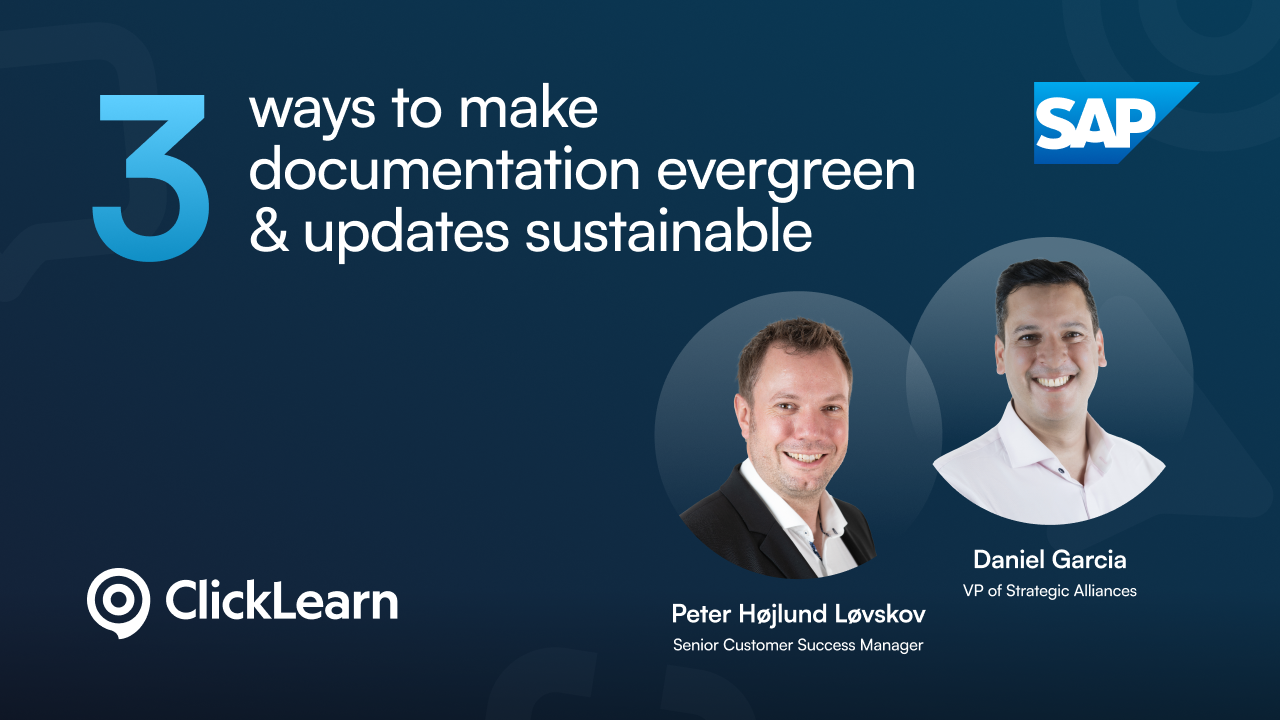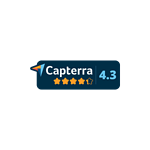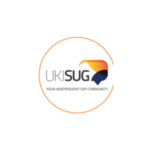Webinar
3 ways to make documentation evergreen & updates sustainable

Are SAP system upgrades outpacing your documentation?
We get it. It’s a common struggle to keep up the pace and avoid outdated documentation that frustrates your users.
That’s why we’ve created this LIVE session for the SAP community.
Outdated documentation can be a major productivity drain. But with the right approach, tools, and strategies, you can create and maintain evergreen documentation that evolves with your software in a sustainable way.
In this LIVE session we will dive into how to:
- Create uniform documentation with templates: Ensure consistency across all documentation by using templates, allowing multiple authors to contribute seamlessly.
- Leverage version control: Track changes, revert to previous versions, and identify inconsistencies with a robust version control system.
- Collaborate effectively: Facilitate efficient knowledge sharing, reviews, and updates with a collaborative platform.
Save your spot now and join the SAP community.





3 ways to make documentation evergreen and updates sustainable
Evergreen documentation means having training guides and process materials that stay up-to-date no matter how often your systems change. If you’re an enterprise training manager or an ERP administrator, you know the pain of constantly revising manuals for every software update. The good news is that with the right approach, you can dramatically reduce the time spent updating content and ensure users always have the latest information.
Below, we outline three effective ways to make your documentation evergreen and your update process sustainable. These best practices will help your team streamline content maintenance, improve training scalability, and keep pace with rapid software changes.
1. Reduce manual updates with process recording and auto-generation
The high cost of constant manual updates
Manually updating training content for each change in your ERP or business applications is time-consuming and inefficient. When documentation relies on copying screenshots and writing steps by hand, even a minor software update can require hours of revisions. This often leads teams to cut corners – such as avoiding detailed screenshots or creating very text-heavy guides – because they fear the “lifetime commitment” of keeping those details updated with every release. The result? Outdated, inconsistent documentation that frustrates users and becomes a maintenance nightmare.
Key impacts of manual documentation:
Wasted time and resources: Authors spend countless hours editing documents instead of focusing on high-value tasks.
Outdated information: If updates aren’t done in time, users end up following old procedures, hurting productivity.
Inconsistent style: Different team members may document processes in varying formats or styles, confusing the audience.
Limited visuals: Teams often exclude screenshots or UI images to avoid update work, making guides less engaging.
Capture processes once, generate documentation everywhere
The solution to minimizing manual work is to leverage process recording tools that automatically generate documentation from a single capture. Instead of writing a step-by-step guide from scratch, you simply perform the procedure in the live system while a recorder tool captures each click, field entry, and screenshot. The recorder then produces the documentation for you – complete with text descriptions and images – based on that captured process.
Benefits of process recording and auto-generation:
Save time on creation: Recording a process can produce a draft document in minutes, which is far faster than writing one manually.
Consistent format: The output follows a standard template, ensuring a uniform look and feel across all your materials. This consistency makes content easier to follow and trust.
Easy edits and updates: Because the documentation is generated from a recording, you can edit the recording (a “living document”) and regenerate updated guides whenever the process changes. You’re not stuck rebuilding the document from scratch; just update the parts that changed.
Empower multiple authors: Subject matter experts can record their own processes without needing to be skilled writers. The tool handles the formatting and wording, so everyone contributes in a consistent way.
By adopting a process capture approach, your team turns tedious manual updates into a more automated workflow. This lays the foundation for truly evergreen documentation – content that can be refreshed quickly whenever something changes.
2. Automate updates as systems change and publish in multiple formats
Keep content evergreen through automated updates
Modern enterprise systems (like ERP, CRM, etc.) receive frequent updates and upgrades. To keep documentation in sync, automation is your ally. With the right tools, you can automatically update screenshots and procedure steps when a new software version is released. For example, if a button label or screen layout changes in your ERP, you can replay the original process recording to capture new screenshots and insert them into your documentation in one go. This means you don’t have to manually redo every screenshot or rewrite text for each minor UI change – the software does it for you.
In addition, maintaining version control on your content is critical. A robust documentation platform will allow you to maintain multiple versions of the same guide (e.g. for different software releases or system configurations) and control which version each user sees. This way, your audience always accesses the relevant, up-to-date version for their environment.
Tips for automating content updates:
Track system changes: Coordinate with your IT or software vendors so you know when updates are coming. Plan a documentation review immediately after a major update.
Use replay or update features: If using a recording tool, take advantage of any “replay” or “update screenshots” function to refresh visuals without manual effort.
Version your documents: Label documentation by software version or date. Archive older versions and clearly publish the latest so users aren’t misled by legacy info.
Regularly review content: Set a schedule (e.g. quarterly) to audit and update key documents even if there’s no big software release. This catches any small drift in processes over time.
Single-source publishing to multiple formats
Another pillar of sustainable documentation is the ability to create multiple outputs from one source. Different users prefer or require different formats for learning – some might want a PDF manual, others a quick video tutorial, and others an in-app help article. Manually creating and updating each format separately is a huge drain on resources and increases the chance of inconsistencies. The better approach is to maintain one single source of truth (like a process recording or master document) and let technology publish it in various formats automatically.
For instance, a single recorded process can be published as:
Step-by-step written guides (for printouts or PDFs)
Video demonstrations with auto-generated voiceover
Interactive simulations where users can practice steps
HTML knowledge base articles in a learning portal or intranet
Because all these outputs come from the same source, updating the source (the original recording or master content) means you can regenerate all formats at once. This ensures every format (video, PDF, etc.) stays consistent and current without extra work. It also improves accessibility of your training – users can pick the format that suits them best, knowing it’s always the latest version.
By automating both the updating process and the multi-format publishing, you drastically cut down the effort needed to support users across different roles and preferences. Your documentation truly becomes “write once, use everywhere,” which is the hallmark of evergreen content.
3. Embrace best practices for sustainable ERP documentation
Even with great tools, having the right process and culture around documentation is essential to keep it evergreen. Here are some best practices to adopt across your ERP and enterprise environments to ensure documentation remains sustainable:
Establish a template and style guide: Use standardized templates for all documentation. This not only ensures consistency but also makes it easier to update content, since every guide follows the same structure. Templates prevent reinventing the wheel each time and help multiple authors contribute smoothly.
Enable collaboration: Sustainable documentation is a team effort. Involve process owners, trainers, IT staff, and business users in contributing to and reviewing content. Use a collaborative platform where multiple authors can work on the same project and share feedback. This way, knowledge isn’t siloed – everyone works on a single source of truth.
Align with release cycles: Treat documentation updates as an integral part of your software release management. For each ERP update or new feature rollout, assign someone to record or update the relevant processes. Having a game plan for frequent updates ensures you don’t fall behind and end up with stale content.
Centralize access to content: Provide a one-stop access point (like an online portal or knowledge base) for all training materials. When users know exactly where to find the latest documentation, they’re more likely to rely on it. This also helps administrators ensure only the latest version is in circulation.
Monitor and get feedback: Track which documents are most used and solicit user feedback on them. If certain guides are frequently referenced, ensure they are always top-notch and current. User feedback can also highlight if something is outdated or unclear, prompting a timely update.
By embedding these practices in your training program, you create a culture of evergreen documentation. Your team and stakeholders recognize that learning materials are living documents that evolve along with the business systems. Over time, this reduces the scramble of reactive updates because continuous improvement is built into your process.
In summary, making documentation evergreen and sustainable comes down to working smarter, not harder. Capture processes instead of writing them out, automate the upkeep whenever possible, and foster a collaborative approach to content maintenance. The payoff is huge: your end-users get accurate, up-to-date guidance whenever they need it, and your training team frees up time to support strategic initiatives instead of chasing document updates.
Learn how to put these strategies into practice by watching our free on-demand webinar, “3 Ways to Make Documentation Evergreen and Updates Sustainable.” See real examples of process recording, automated updates, and multi-format publishing in action, and get expert tips on kickstarting an evergreen documentation strategy in your organization.